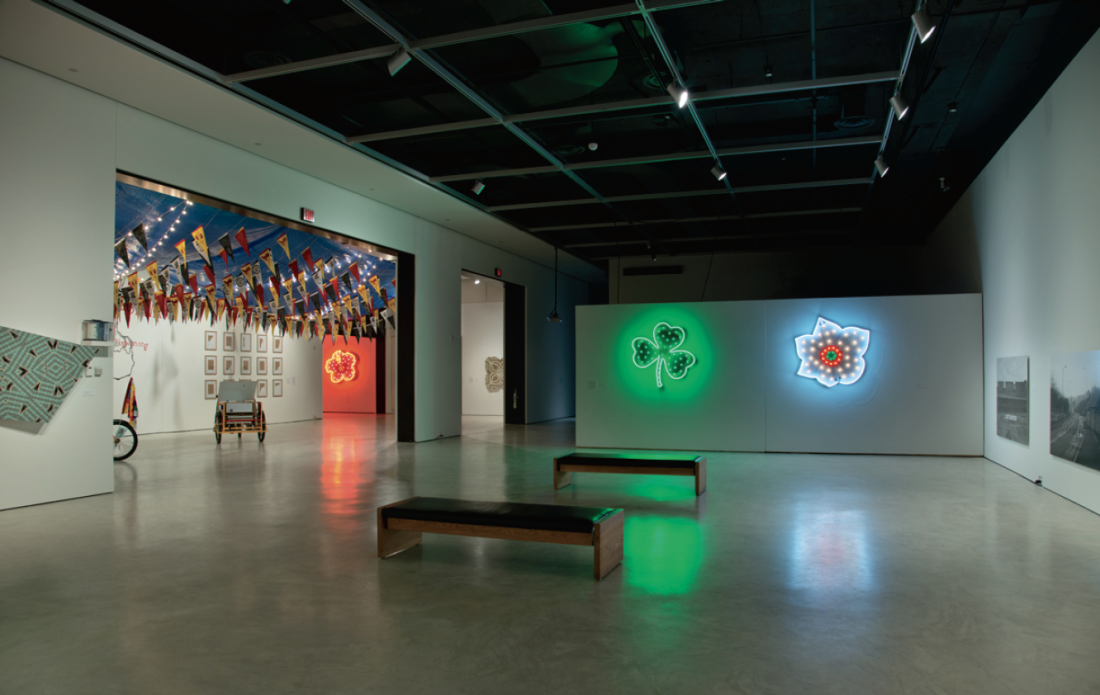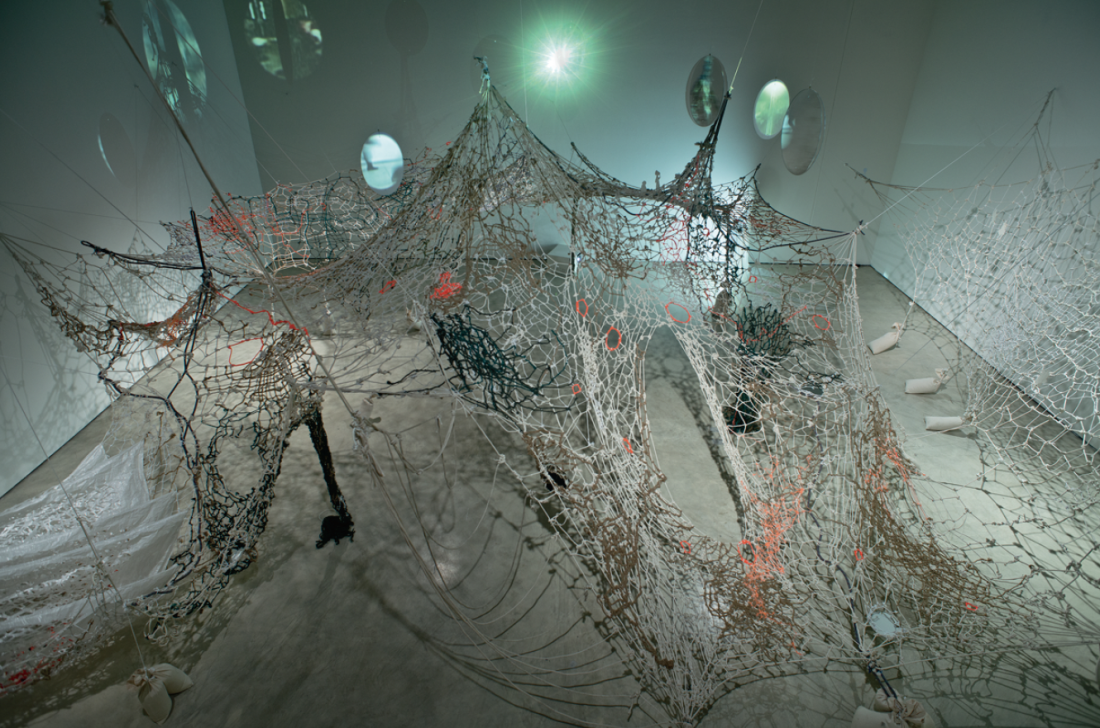“Border Cultures: Part One (homes, land)”
“Border Cultures: Part One (homes, land)” is the first in a series of three exhibitions curated by Srimoyee Mitra at the Art Gallery of Windsor. “Border Cultures: Part Two (work, labour) and “Border Cultures Part Three (security, surveillance) will take place between now and 2015.
The Canada/US border is intrinsic to Windsor, a city still largely defined by its role as trade portal and manufacturing partner. Conceived in an effort to unpack some of the critical language in border cities, Mitra, in this series of exhibitions, hopes to engender a larger discourse around the effect of the boundary through contemporary artworks. “Border Cultures: Part One” gathers work from Broken City Lab (Canada), Iftikhar and Elizabeth Dadi (US), Dylan Miner (US/Canada), Christopher McNamara (Canada/US), Ed Pien (Canada), Willie Doherty (Ireland), Campus in Camps (Palestine), Marcos Ramirez Erre (Mexico/US), Leila Sujir and Maria Lantin (Canada) and Sanaz Mazinani (Canada).

“Border Cultures: Part One (homes, land),” installation view, courtesy the Art Gallery of Windsor. Photography: Frank Piccolo.
Dominating the entrance to the exhibition is Dylan Miner’s work Remapping the Illegitimate Border. Colourful flag bunting, tarps and portable screen printing/ cycling-hybrid apparatus are evidence of Miner’s social research practice. Engaging with Aboriginal and Latino youth from both sides of the Canada/US border, Miner explores the collision between cultural and state boundaries. A large wall painting delineates the cultural territory bisected by the Detroit river and the Canada/US border. On either side of the wall painting are framed maps, resectioned and stamped as accessioned to “The Library of Indigenous Radicalism” on December 23rd, 1814—the day prior to the signing of the Treaty of Ghent. The Library, an ongoing project for Miner, collects and presents objects that disrupt the settler history, effectively opening a fissure and creating a space for what he terms “speculative history.” Miner’s work reimagines the border zone as a site of collaborative activity where bifurcated communities can reconnect and establish icons alternative to those imposed by the state.
While Miner’s work attends specifically to the social and historical aspects of the local border, Broken City Lab wishes to erase the boundary altogether. In its best moments How to Forget the Border Completely, a publication from the collective, amounts to an eccentric guidebook to the Windsor/Detroit crossing. Taking a playful approach to the increasingly complicated and militarized process, the chapter “An Imaginary Consultancy for Canadian Customs” proposes amendments to current procedures. In the form of a corporate training manual, the text recognizes the border as an economic force and suggests it implement an alternative customer service model; one where a customs agent might serenade while searching.
Fictionalized narratives are a common strategy in a number of the works included in this exhibition. Postcards from the Edge by Marcos Ramirez Erre pairs photographs from his personal collection with short missives written by people from one side of the border to another. The works are formatted as enlarged postcards, messages able to travel easily through a hostile border. The images Erre selects oppose the tourist postcard and reflect locality. The work shifts the postcard from tourist souvenir to an examination of how the border separates people from place.
Campus in Camps’s School in Exile is a collaborative architectural project located in Shu’fat, a refugee camp on the boundary of Jerusalem. A large mural print of the territory occupies an entire wall of the gallery space, the cramped architecture of a temporary community. A small model to the side invites visitors to play with and invent or reconfigure spaces in the school as a means of creating dialogue about structures that occupy disputed, temporary zones. Though Shu’fat was established nearly 50 years ago as a refugee camp, it is dislocated from certain aspects of the creation of a new town. School in Exile remediates this by aspiring to an architecture that is responsive to the community rather than imposed.

Ed Pien, Memento, 2009, installation, “Border Cultures: Part One,” dimensions variable. Commissioned by the Chinese Arts Centre, Manchester, England. Courtesy Birch Libralto, Toronto.
Near School in Exile hang Willie Doherty’s large-scale photographs of Derry, Ireland. Bold text indivisible from and at odds with what is immediately available in the photographic image challenge the interpretation of the work. Unable to divorce the anonymous fortified buildings, fences and empty roads from the language of security and occupation (fixed parameter, remote control, undercover, unseen to the border and last bastion) the images challenge what can be known about any given place by looking.
Interspersed throughout the gallery space are works from Iftikhar and Elizabeth Dadi. The large neons that make up Efflorescence assert themselves among the other works, glowing, emanating. Representing the national flowers of Sudan (hibiscus), North Korea (magnolia), Ireland (clover) and Palestine (poppy), these national emblems are repurposed as signage—signifiers for national identity—and used in this exhibition to contrast works like Remapping the Illegitimate Border, which challenge the veracity of national mythologies.
Contemplating migrant populations, Ed Pien’s installation work, Memento, is a claustrophobic tangle of rope and intersecting video projections on oval mirrors. Located in a room outside of the main gallery space, Memento has a haunting quality, teasing questions of visibility and labour. As the mirrors rotate, images shift in and out of view; anonymous figures, some barely visible, blend with the shadows cast by the net encompassing the room. The work was first created as Pien completed a residency at the Chinese Arts Centre in Manchester, England.
Srimoyee Mitra has undertaken an ambitious project in Border Cultures. In engaging artists with such a variety of practices and methodologies this exhibition doesn’t aspire to a cohesive curatorial narrative. Rather, it obsessively gathers and presents as many differing projects as it can. Presenting them all at once, together, Mitra asks that we reflect on our own relationships to place, and how those relationships are affected by state boundaries. ❚
“Border Cultures: Part One (homes, land)” was exhibited at The Art Gallery of Windsor, Windsor, from January 25 to March 31, 2013.
Nadja Pelkey is an artist and writer living in Windsor, Ontario.

